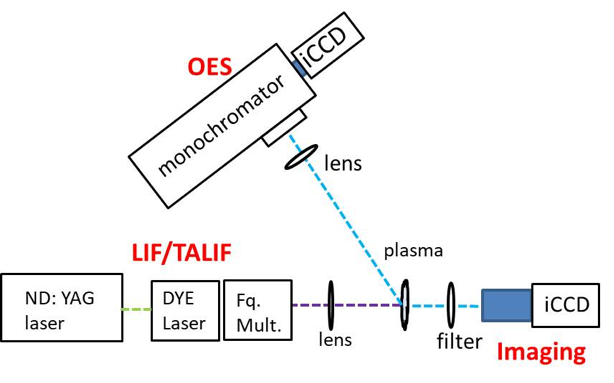Laser-Induced Fluorescence

Laser-induced fluorescence (LIF) is an active spectroscopy diagnostics method that allows probing the populations of atoms and molecules with excellent spatial and temporal resolution. For atomic species LIF relies on resonant excitation of atoms into a higher electronic state. The excited atom then decay into a lower energy state, subsequently emitting a fluorescent photon. The detection of fluorescence allows, in-principle, to deduce the population of the ground state, with absolute densities inferred via suitable calibration methods. The application of high-power pulsed lasers with highly collimated and coherent beams makes LIF very sensitive technique where the fluorescence can be detected in concentrations of species a low as 109 cm-3 and discriminated from a background of continuum of line emission of plasma.
The excitation wavelengths of light atoms are more energetic and located in vacuum ultraviolet (VUV) spectral range and hence are not accessible by conventional laser systems. Additionally, many gases at elevated densities strongly absorb the VUV radiation.Both of these issues are overcome by utilization of two-photon laser induced fluorescence (TALIF), there the two photon excitation is realized via a virtual energy level.
The available LIF diagnostic is based on a dye laser (Spectra-Physics Cobra Stretch) pumped by pulsed Nd:YAG laser (Continuum SL-III). The pump laser generates 8 ns pulses with energy 1J at 1064 nm, 0.55 J at 532 nm and 0.25 J at 355 nm which is sufficient for implementation both LIF and TALIF diagnostics. The dye laser is equipped with non-linear crystals frequency multiplication and difference-frequency generation to provide continuous laser wavelength coverage between 197 nm and 900 nm and 1400-5000 nm.
Our system allows us to implement planar geometry of LIF (pLIF) and TALIF diagnostics in a conjunction to conventional LIF scheme. Planar geometry delivers instantaneous distribution of species of interest at selected state along the laser beam expanded into a sheet. The use of two-photon absorption process allows probing the ground state of species of interest that deliver accurate absolute number density. The data from planar TALIF diagnostic reflect information about selected gas flow pattern that is very important input for simulation codes.